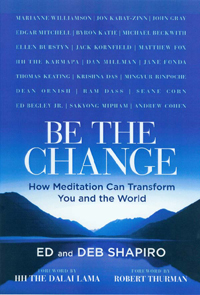
Listen to CNN or any news channel or read the newspapers and you will find the word mantra used to mean any oft-recited saying, whether positive or not. For instance, James Arthur Ray, well-known from 'The Secret' and the latest 'guru' to hit the headlines, uses motivational mantras promising endless spiritual and financial wealth, while the tea-baggers believe their mantra that 'socialism is bad.' President Obama's mantra, “Yes we can!" is an inspiring and affirmative one.
This use of the word mantra has arisen from the traditional custom of chanting sacred sounds or names, as done in many religious practices. Such repetition has also been put to music that reaches across religious boundaries.
The room was filled with melodious voices. We were at a concert with the fabulous Deva Premal and Miten. They are masters at chanting, and at getting the audience to participate. Spending a few hours singing a foreign language (many chants are in Sanskrit) may not sound like a lot of fun, yet it has a remarkable effect. It really does uplift the spirit.
Sounding in this way is not only a means of worshipping the sacred but
also creates harmony by unifying voices into a synchronized whole. This is
particularly effective if the sound does not require thought, such as chanting
in Latin, as it is the sound that is important and not the meaning. However, the
unity can easily be lost if the thinking mind intrudes.
Deepesh Faucheux, who was a Catholic monk, told us in
our latest book (see below) about the effect of the Gregorian chanting in his
monastery: " Gregorian frequency works on the brain in a particular way to
elevate us to a spiritually altered state. It was always a collective
chant—what is called ecclesia. A group of people with a single purpose
of worship attuned together, their behavior, sensibilities, and moods all
harmonized. The frequency of the sound deeply affected us, it smoothed out the
rough edges, anger or fear. It was like Prozac, I would get very high, even
transported. It made many of the petty things that happened seem totally
unimportant and made life in the monastery bearable, even blissful. It was the
only therapy the monastery needed! But when we stopped chanting in Latin and
tried to do it in the local dialect, many of the monasteries and convents fell
apart because the people started fighting with each other. They had lost that
shared integrative quality.”
Apart from calming the mind and reducing friction,
chanting can also be powerfully healing. Miten shared the moving story of a
woman who had been deeply depressed for two years, sleeping on the couch as she
could not climb the stairs, waking up each morning hoping she would die, and gaining
a lot of weight. A friend played her Deva and Miten's chanting and she began to
sob, followed by a huge release. She played their music constantly and one
morning, when she woke up, for the first time she was able to appreciate the
sun filling her room. She had thoughts of how she could share love, instead of
longing to die.
Deva and Miten hear such stories constantly,
especially from people who know nothing of the meaning of the chant but who are
feeling a lack of shared spirituality in their lives and who experience a deep and
joyful resonance with the sound.
Ed learnt chanting when he lived in India. While on a
teaching tour a man came to him and asked for Ed to come to his home to see his
ailing wife. When Ed entered their simple mud hut, he chanted a healing mantra—Om Namah Shivaya—over the woman's bed.
She immediately lit up with a big smile and grasped his hand.
In this context, a mantra is a word or phrase that has
special meaning, such as shalom, peace
or shanti. It may be the name of a spiritual being, such as Mother Mary, Hare Krishna, or Namo Buddha.
In the east Om or Aum is a favorite sound as it means the sound of the universe. Or,
as the western spiritual teacher Ram Dass, says: “Each person can use the
mantra ‘I am loving awareness.’ Just repeat this and become loving awareness.
Then share that loving awareness with all others.”
Mantra meditation is like spiritual food; it awakens your
creative process and nourishes your spirit, while habitual or agitated thinking
patterns are released. In the process you discover the silence behind the sound.
It is like a broom that sweeps your mind free of clutter. What more could you
want?
Mantra Meditation
To practice mantra meditation, sit
comfortably with your back straight. Take a few deep breaths and relax and
settle your body. Then begin to repeat the mantra, either silently or intoning
it out loud if you are alone. Repeat it in rhythm with your breathing. If you
get distracted or drift off into thinking, just bring your mind back to the
sound.
Deva Premal and Miten
have many different concerts lined up, so check their website for one near you.
What do you
feel about mantras? Do comment below. You can receive notice of
our blogs every Tuesday by checking Become
a Fan at the top.
You can pre-order a copy of our book at: BE THE CHANGE, How Meditation Can
Transform You and the World. It will be published Nov 3rd. Join us for
a booksigning: Nov 3rd in Boulder CO; Nov 11th in Portland OR; Nov 13th in Seattle
WA; Nov 16th in NYC; and Nov 17th in Springfield MA. More details at: www.EdandDebShapiro.com

****
Ed and Deb Shapiro’s new book, BE THE CHANGE, How Meditation Can Transform
You And The World, with forewords by the Dalai Lama and Robert Thurman,
with contributors such as Marianne Williamson, astronaut Edgar Mitchell, Ellen
Burstyn, Michael Beckwith, Jon Kabat-Zinn, Jane Fonda, Jack Kornfield, Byron
Katie, Dean Ornish, Deva Premal & Miten, and Deepesh Faucheux will be published Nov 3rd
2009 by Sterling Ethos. Deb is the author of the award-winning book YOUR
BODY SPEAKS YOUR MIND. Ed and
Deb are the authors of over 15 books, and lead meditation retreats and
workshops. Enjoy their 3 meditation CD’s: Metta - Loving kindness and Forgiveness;
Samadhi
– Breath Awareness and Insight; and Yoga Nidra – Inner Conscious
Relaxation, available on their website:
www.EdandDebShapiro.com